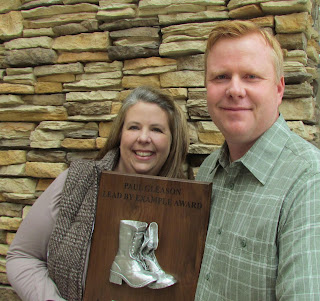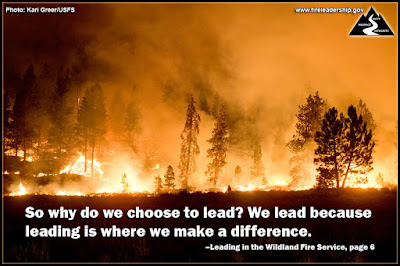Jan. 26, 2016 — COLLEGE STATION, Texas — The Lone Star State Type II Initial Attack Crew from Texas A&M Forest Service recently received honorable mention in the 2015 IGNITE the Spark for Leadership Award for its commitment to developing leaders.
The award recognizes leadership development efforts within the wildland fire community. In the spirit of healthy competition, this year’s theme was “Followership is Leadership.”
"We've heard firefighters say they’re too busy fighting fires to 'do' leadership. We designed this challenge as a way to incorporate leadership development throughout the wildland fire service,” said Pam McDonald of the National Wildfire Coordinating Group's Leadership Subcommittee. “Leadership is not just something we do as part of our day job. Leadership transcends the fireline, making personal lives and society as a whole better.”
The Lone Star State Crew consists of 46 personnel from across Texas, with various backgrounds including forestry, wildfire, predictive services, training and finance. Being scattered throughout Texas presents unique challenges, however, the crew maintains cohesion and functionality.
“I’m proud of the success of the crew,” Rich Gray, Texas A&M Forest Service task force coordinator said. “My admiration of this crew is that egos and authorities are left at home and the crew functions as a cohesive team with each crew member having valuable and respected input.”
Over the last year, the Lone Star State Crew worked on increasing skill sets and developing crew members into frontline leaders. This includes participating in several week-long training exchanges with the Texas Parks and Wildlife Department and the USDA Forest Service including prescribed fires, saw work, unit preparation, incident within an incident scenarios and fire ecology classes.
“As a crew we are constantly developing leadership amongst our ranks. Some of the best leaders we have on the crew do not serve in leadership positions but still mentor those around them,” Steven Moore, Texas A&M Forest Service resource specialist said.
Although the crew was formed over two years ago, 2015 presented the first opportunity for them to respond out of state at the Colville National Forest in Washington.
“My time in Washington showed me what a leader should be. It was my first time out on assignment and my crew bosses always kept me informed of changes. At no point did I ever feel that my voice or opinion couldn’t be heard,” Charles Sanson, Texas A&M Forest Service resource specialist said. “Communication was a key aspect in our crew’s success.”
Texas A&M Forest Service positions itself as a leader in incident response and this recognition demonstrates one of the many ways the agency develops nationally-recognized leaders within its ranks.
"We are following in the path of previous TFS leaders and building the foundation and skill sets required to lead at various levels,” Gray said. “The experiences and lessons learned here will translate into future leaders within the agency."
Members of the Lone Star State Type II Initial Attack Crew are: Steven Moore, Rich Gray, Bryan Collins, Dustin Morris, Colton Curles, Danny Al-Batal, Brian Backhaus, William Gage, Jared Karns, Mike Kuhnert, Andy McCrady, Matthew Bernhardt, Mitch LaMonte, Gabe Mahlum, Will Rosen, Travis Sagebiel, Logan Scherschel, Kelly Reeves-Weaver, Jason Calvet , Jason Furmaniak, Bryant “Del” Birdwell, Kevin Boyd, Nick Dawson, Corby Kokemoor, Ryan Laube, Meredith McNeil, Lance McDaniel, Joshua Mizrany, Calvin Newman, Crockett Pegoda, Wade Powell, Tyler Slaydon, Matthew Whelan, Steve Willingham, Cody Lambert, Gerald Baker, Lee Andersen, Elliot Borman, Mark Fikes, Kari Hines, David Ivy, Zack Jones, Luke Kanclerz, Nicole Lang, Colton Newton, Sal Machado, Charles Sanson, Jordan Smith, Steven Smith, Robert Webster and John Will.
To learn more about the awards visit
http://www.fireleadership.gov/index.html.
###
Texas A&M Forest Service Contacts:
Steven Moore; Resource Specialist; 254-716-9595;
smoore@tfs.tamu.edu
Jessica Jackson; Communications Specialist; 979-458-6619;
jjackson@tfs.tamu.edu
Reprinted from the
Newsroom.

























